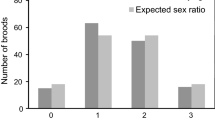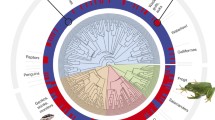Abstract
Despite the growing literature on facultative sex-ratio adjustment in chromosomal sex-determining vertebrate taxa (birds, mammals), the consistency of results is often low between studies and species. Here, we investigate the primary and secondary offspring sex ratio of a small passerine bird, the Eurasian Penduline Tit (Remiz pendulinus) in three consecutive years. This species has a uniquely diverse breeding system, in which the male (and/or the female) abandons the nest during egg-laying, and starts a new breeding attempt. This allowed us to test (1) whether patterns of parental care, i.e., male-only care, female-only care or biparental desertion, influence offspring sex ratio, and (2) whether the offspring sex ratio is repeatable between successive clutches of males and females. Using molecular markers to sex 497 offspring in 176 broods, we show that (1) offspring sex ratio does not depend on which parent provides care, and (2) the offspring sex ratio is not repeatable between clutches of a given individual. The overall primary and secondary offspring sex ratio at a population level is not different from parity (54 ± 6% males, and 50 ± 3% (mean ± SE), respectively). We suggest that ecological and phenotypic factors, rather than individual traits of parents, may influence offspring’s sex, and conclude that there is currently no evidence for a facultative adjustment of offspring sex ratio in the Penduline Tit.
Similar content being viewed by others
References
Badyaev AV, Hill GE, Beck ML (2003) Interaction between maternal effects: onset of incubation and offspring sex ratio in two populations of a passerine bird. Oecologia 135:386–390
Bleeker M, Kingma SA, Szentirmai I, Székely T, Komdeur J (2005) Body condition and clutch desertion in penduline tit Remiz pendulinus. Behaviour 142:1465–1478
Cassey P, Ewen JG, Møller AP (2006) Revised evidence for facultative sex ratio adjustment in birds: a correction. Proc R Soc Lond B 273:3129–3130
Charnov EL (1982) The theory of sex allocation. Princeton University Press, Princeton
Cichoń M, Dubiec A, Stoczko M (2003) Laying order and offspring sex in blue tits Parus caeruleus. J Avian Biol 34:355–359
Clutton-Brock TH (1986) Sex-ratio variation in birds. Ibis 128:317–329
Clutton-Brock TH (1991) The evolution of parental care. Princeton University Press, Princeton
Cockburn A, Legge S, Double MC (2002) Sex ratios in birds and mammals:can the hypotheses be disentangled? In: Hardy I (ed) Sex ratios. Concepts and research methods. Cambridge University Press, Cambridge, pp 266–286
Cramp S, Perrins CM, Brooks DJ (1993) Birds of the Western Palearctic, vol VII. Oxford University Press, Oxford
Daan S, Dijkstra C, Weissing FJ (1996) An evolutionary explanation for seasonal trends in avian sex ratios. Behav Ecol 7:426–430
Dean WRJ (2005) Cape penduline tit Anthoscopus minutus. In: Hockey PAR, Dean WRJ, Ryan PG (eds) Roberts Birds of Southern Africa. John Voelker Bird Book Fund, Cape Town, pp 736–737
Dietrich-Bischoff V, Schmoll T, Winkel W, Krackow S, Lubjuhn T (2006) Extra-pair paternity, offspring mortality and offspring sex ratio in the socially monogamous coal tit (Parus ater). Behav Ecol Sociobiol 60:563–571
Dijkstra C, Bult A, Bijlsma S, Daan S, Meijer T, Zijlstra M (1990) Brood size manipulations in the kestrel (Falco tinnunculus): effects on offspring and parent survival. J Anim Ecol 59:269–286
Ewen JG, Cassey P, Møller AP (2004) Facultative primary sex ratio variation; a lack of evidence in birds? Proc R Soc Lond B 271:1277–1282
Fawcett TW, Kuijper B, Pen I, Weissing FJ (2007) Should attractive males have more sons? Behav Ecol 18:71–80
Festa-Bianchet M (1996) Offspring sex ratio studies of mammals: does publication depend upon the quality of the research or the direction of the results? Ecoscience 3:42–44
Fiala KL (1980) On estimating the primary sex-ratio from incomplete data. Am Nat 115:442–444
Fisher RA (1930) The genetical theory of natural selection. Oxford University Press, Oxford
Franz D (1988) Das Paarungssystem der Beutelmeise (Remiz pendulinus)—ein Kampf der Geschlechter. J Orn 129:107–111
Franz D (1991) Mating system and strategy of reproduction in penduline tit (Remiz p. pendulinus). J Orn 132:241–266
Glutz von Blotzheim UN, Bauer KM (1993) Handbuch der Vögel Mitteleuropas, vol 13/2. Aula, Wiesbaden
Griffin AS, Sheldon BC, West SA (2005) Cooperative breeders adjust offspring sex ratios to produce helpful helpers. Am Nat 166:628–632
Griffiths R, Double M, Orr K, Dawson R (1998) A simple DNA test to sex most birds. Mol Ecol 7:1071–1076
Grindstaff JL, Buerkle CA, Casto JM, Nolan V Jr, Ketterson ED (2001) Offspring sex ratio is unrelated to male attractiveness in dark-eyed Juncos (Junco hyemalis). Behav Ecol Sociobiol 50:312–316
Hamilton WD (1967) Extraordinary sex ratios. Science 156:477–488
Harper DGC (1994) Some comments on the repeatability of measurements. Ringing Migr 15:84–90
Hasselquist D, Kempenaers B (2002) Parental care and adaptive brood sex ratio manipulation in birds. Philos Trans R Soc Lond B 357:363–372
Hipkiss T, Hornfeldt B (2004) High interannual variation in the hatching sex ratio of Tengmalm’s Owl broods during a vole cycle. Popul Ecol 46:263–268
Kempenaers B, Verheyen GR, Dhondt AA (1997) Extrapair paternity in the Blue Tit (Parus caeruleus): female choice, male characteristics, and offspring quality. Behav Ecol 8:481–492
Kilner R (1998) Primary and secondary sex ratio manipulation by zebra finches. Anim Behav 56:155–164
Kingma SA, Szentirmai I, Székely T, Bókony V, Bleeker M, Liker A, Komdeur J (2008) Sexual selection and the function of a melanin-based plumage ornament in polygamous penduline tits Remiz pendulinus. Behav Ecol Sociobiol (in press)
Komdeur J, Daan S, Tinbergen JM, Mateman C (1997) Extreme adaptive modification in sex ratio of the Seychelles Warbler’s eggs. Nature 385:522–525
Komdeur J, Magrath MJL, Krackow S (2002) Pre-ovulation control of hatchling sex ratio in the Seychelles warbler.Proc R Soc Lond B 269:1067–1072
Komdeur J, Pen I (2002) Adaptive sex allocation in birds: the complexities of linking theory and practice. Philos Trans R Soc Lond B 357:373–380
Korsten P, Lessells CM, Mateman AC, van der Velde M, Komdeur J (2006) Primary sex ratio adjustment to experimentally reduced male UV attractiveness in blue tits. Behav Ecol 17:539–546
Krebs EA, Green DJ, Double MC, Griffiths R (2002) Laying date and laying sequence influence the sex ratio of crimson rosella broods. Behav Ecol Sociobiol 51:447–454
Leech DI, Hartley IR, Stewart IRK, Griffith SC, Burke T (2001) No effect of parental quality or extrapair paternity on brood sex ratio in the blue tit (Parus caeruleus). Behav Ecol 12:674–680
Lessells CM, Boag PT (1987) Unrepeatable repeatabilities—a common mistake. Auk 104:116–121
Minitab 12.2 (2004) Minitab, Pa., USA
Oddie KR, Reim C (2002) Egg sex ratio and paternal traits: using within-individual comparisons. Behav Ecol 13:503–510
Palmer AR (2000) Quasireplication and the contract of error: lessons from sex ratios, heritabilities and fluctuating asymmetry. Annu Rev Ecol Syst 31:441–480
Persson O, Öhrström P (1989) A new avian mating system: ambisexual polygamy in the penduline tit (Remiz pendulinus). Ornis Scand 20:105–111
R Development Core Team (2005) A language and environment for statisticalcomputing. R Foundation for Statistical Computing, Vienna, Austria
Radford AN, Blakey JK (2000) Is variation in brood sex ratios adaptive in the great tit (Parus major)? Behav Ecol 11:294–298
Resampling Stats™ for Excel (2006) Resampling Stats, Arlington, Va.
Saino N, Ellegren H, Møller AP (1999) No evidence for adjustment of sex allocation in relation to parental ornamentation and paternity in Barn Swallow. Mol Ecol 8:399–406
Sheldon BC, Andersson S, Griffith SC, Örnborg J, Sendecka J (1999) Ultraviolet colour variation influences blue tit sex ratios. Nature 402:874–877
Sokal RR, Rohlf FJ (1995) Biometry: the principles and practice of statistics in biological research, 3rd edn. Freeman, New York
SPSS 12.0.0 (2003) SPSS Inc, 1989–2003.Chicago
Székely T, Cuthill IC, Yezerinac S, Griffiths R, Kis J (2004) Brood sex ratio in the Kentish Plover. Behav Ecol 15:58–62
Szentirmai I, Komdeur J, Székely T (2005) What makes a nest building male successful? Male behaviour and female care in penduline tits. Behav Ecol 16:994–1000
Szentirmai I, Székely T, Komdeur J (2007) Sexual conflict over care: antagonistic effect of clutch desertion on reproductive success of male and female penduline tits. J Evol Biol 20:1739–1744
Trivers RL, Willard DE (1973) Natural selection of parental ability to vary the sex ratio of offspring. Science 179:90–92
van Dijk RE, Szentirmai I, Komdeur J, Székely T (2007) Sexual conflict over care in penduline tits: the process of clutch desertion. Ibis 149:530–534
Walsh PS, Metzger DA, Higuchi R (1991) Chelex 100 as a medium for simple extraction of DNA for PCR-based typing from forensic material. Biotechniques 10:506–518
West SA, Sheldon BC (2002) Constraints in the evolution of sex ratio adjustment. Science 295:1685–1688
West SA, Reece SE, Sheldon BC (2002) Sex ratios. Heredity 88:117–124
Westneat DF, Stewart IRK, Halpin Woeste E, Gipson J, Abdulkadir L, Poston JP (2002) Patterns of sex ratio variation in house sparrows. Condor 104:598–609
Whittingham LA, Dunn PO, Nooker JK (2005) Maternal influences on brood sex ratios: an experimental study in tree swallows. Proc R Soc Lond B 272:1775–1780
Acknowledgments
We would like to thank the people that assisted in the field work: Maarten Bleeker, Dušan Brinkhuizen, Kenneth Hayes, Péter Horváth, Arno wa Kang’eri, Sjouke Kingma, Otília Menyhárt and Lídia Mészáros. We also acknowledge Kiskunság National Park and Szegedfish Ltd for permission to carry out our fieldwork at Fehértó. The manuscript benefited from comments on earlier drafts by Tim Fawcett, Thomas Friedl, and one anonymous reviewer. The research leading to these results has received funding from the European Community’s Sixth Framework Programme (FP6/2002–2006) under contract no. 28696. Further financial support was provided by a University Studentship of the University of Bath to R.E.v.D., and grants from the Hungarian National Science Foundation (OTKA T031706, T043390) and a Royal Society Joint Project grant (15056) to T.S. T.S. was also supported by The Leverhulme Trust (RF/2/RFG/2005/0279) and a HRDY Visiting Fellowship of Harvard University. The fieldwork carried out for this study complies with the Hungarian law.
Author information
Authors and Affiliations
Corresponding author
Additional information
Communicated by T. Friedl.
Rights and permissions
About this article
Cite this article
van Dijk, R.E., Komdeur, J., van der Velde, M. et al. Offspring sex ratio in the sequentially polygamous Penduline Tit Remiz pendulinus . J Ornithol 149, 521–527 (2008). https://doi.org/10.1007/s10336-008-0299-5
Received:
Revised:
Accepted:
Published:
Issue Date:
DOI: https://doi.org/10.1007/s10336-008-0299-5




